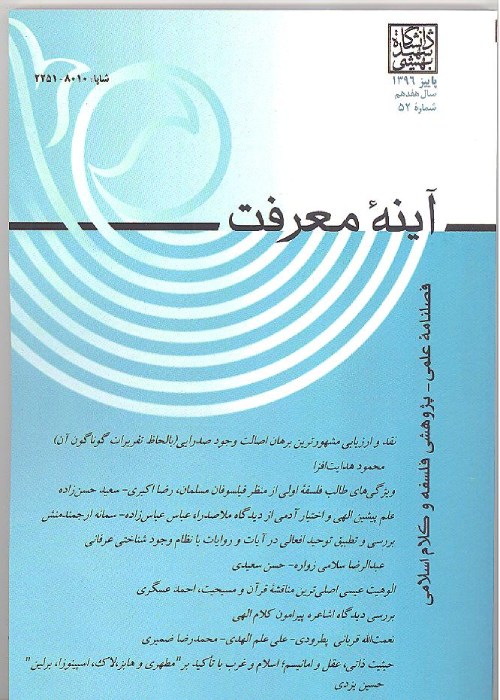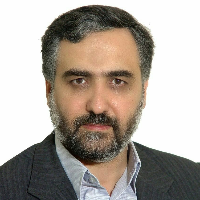Ibn Sīnā’s Mystical Anthropology in The Riîsālât al-Ṭâyr (A Treatise on Birds)
Ibn Sīnā has allocated the last three chapters (nâmâṭs) of his last work, Âl-Îshārāt vâ al-Tânbīhāt (Pointers and Reminders) to the exposition and defense of mysticism. Besides, he has described a period of intellectual and spiritual wayfaring in his Rîsālât al-Ṭâyr by a symbolic language. The main story of this treatise is about some deceived birds that were caught in a hunter’s trap. According to the story, a bird which is the narrator of the story, by seeing the free birds, became aware of his captivity and remoteness and asks them for helping to save and free himself and other trapped birds. In this treatise, Ibn Sīnā depicts the descent of the soul from the world of spirits to the terrestrial world and the ascent of the human rational soul from the degree of corporeal detachments and being caught in the trap of worldly dependencies to the highest degree of spiritual perfection and the degree of Vision of God. For Ibn Sīnā, the wayfarer who has been caught in a trap and realized the depth of his remoteness and captivity, starts a journey with the trapped birds and arrives at the palace of King and asks the king to dig out the remained bonds from their feet. But the time of Permanent liberation from captivity and the rescue from remoteness has not yet come. In the Rîsālât al-Ṭâyr, from an anthropological perspective, Ibn Sīnā has expressed the situation of the wayfarer in a way that is very close to the way of Illuminative Philosophers and the Mystics. Hence, this treatise can be considered as one of the sources of the thoughts of the Illuminative Philosophers. In this treatise, Ibn Sīnā deals with the descent of the soul and its ascent and immortality. For him, the soul after falling into the darkness of the world is trapped and must liberate itself from the trap by a movement of perfection, and ascend to its original homeland. If the soul do so, it will display the truths of the unseen world in itself and return to its lost origin. For this reason, Ibn Sīnā speaks of the stages of wayfaring. In his view, the Bird is the symbol of the rational soul or human soul, the Hunter is the symbol of the nature and material world, and the Trap or Cage is the symbol of the body and corporeal detachments which prevent the soul from flying to the spiritual worlds. Also, in his opinion, the Flight is the symbol of the soul’s effort to reach perfection and ascending from corporeal detachments and reach spiritual degrees and the Vision of the King. Besides, in his belief, the Free Birds are the symbol of the wise and learned men who have found the way to salvation and have reached the complete freedom. Again, in his eye, Liberating from the cage is the symbol of releasing from corporeal detachments, but the birds caught in the trap must travel to the king’s palace and ask for his help in order to reach the complete liberation from the remained detachments. Finally, he believes that passing through each of the nine mountains in this journey is the symbol of the liberation of the rational soul from some detachments to corporeal things, which have prevented the rational soul from transcending and returning to its own origin. In mystical writings, the animal symbols are used to express some truths. Most animals have a symbolic meaning which indicates to the spiritual states of man. In other words, each of the characteristics of the animal soul, which exist in every human being, is attributed to a specific animal. Ibn Sīnā uses various animal symbols to show the elegances of wayfaring and human capabilities during his spiritual journey. The Hedgehog is the first animal symbol that Ibn Sīnā attributes to the wayfarer in his Rîsālât al-Ṭâyr. The wayfarer must collect himself by inspiring from the hedgehog, introspect in himself and engage him carefully and without raising a tumult in self-knowledge. The second animal symbol is the Snake. For Ibn Sīnā, just as a snake comes out of its skin once or twice in a year, the wayfarer must also come out of the world of nature and body, which is a skin for a person, and reach the quintessence. By this shedding the skin, the wayfarer liberates himself from all the corporeal detachments which have occupied his intellectual and spiritual faculties and prevented his soul from flying, and gradually provides his soul for spiritual intuition. The third animal symbol in this treatise is the worm. In Ibn Sīnā’s view, the wayfarer, in his spiritual journey, must walk slowly, cautiously and without any affectation, and not hurting anyone. The fourth animal symbol is the scorpion. Ibn Sīnā believes that the scorpion is a symbol of pure awareness, constant preparation and the restless journeying of the wayfarer, and controlling his sensual and appetitive faculties and turning them into spiritual faculties.Moreover, Ibn Sīnā mentions four other animal symbols which have the characteristics he attributes to them: Ostrich, Viper, Salamander and Bat. Of course, these four animals have vices that a wayfarer must not learn, but they have four virtues that he must learn: the “resistance” of the ostrich, the “persistence” of the viper, the “fire-fighting” of the salamander, and the “day-avoidance” of the bat; i.e. not being a sensualist. By using these symbols beautifully and precisely, Ibn Sīnā has drawn well the spiritual capacities of the wayfarer and the harms of the path. It is the reason that, in this paper, we have discussed descriptively and analytically on Ibn Sīnā’s mystical anthropology according to his view of human capacities and capabilities for spiritual wayfaring, based on the Rîsālât al-Ṭâyr.
- حق عضویت دریافتی صرف حمایت از نشریات عضو و نگهداری، تکمیل و توسعه مگیران میشود.
- پرداخت حق اشتراک و دانلود مقالات اجازه بازنشر آن در سایر رسانههای چاپی و دیجیتال را به کاربر نمیدهد.



